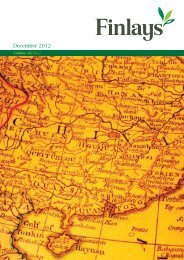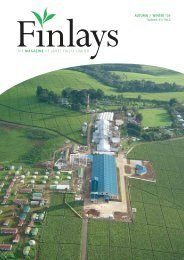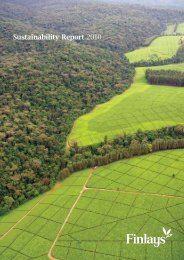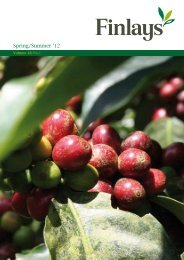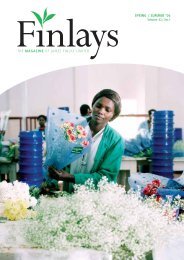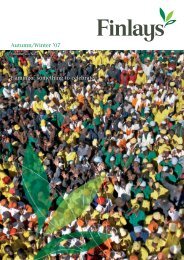You also want an ePaper? Increase the reach of your titles
YUMPU automatically turns print PDFs into web optimized ePapers that Google loves.
16<br />
‘A Special Place in the Heart’ William Henderson<br />
The historic landscape of tea in the Indian<br />
Subcontinent has recently undergone<br />
seismic change. After more than 120<br />
years, <strong>Finlays</strong> called a halt to its<br />
operations in Bangladesh (see our last<br />
edition). Meanwhile, an employee buy-out<br />
by the 12000-strong work force in 2005<br />
once again changed the fortunes of Tata<br />
Tea Limited’s South India Plantation<br />
Division, founded in 1878 by James Finlay<br />
& Co. Ltd., and run by the company until<br />
its Indian estates were finally sold to Tata<br />
in 1982. We asked Bill Henderson, a<br />
former High Range General Manager and<br />
co-author of ‘Facets of a Hundred Years<br />
Planting’, to take a nostalgic look back at<br />
early days in South India’s incomparably<br />
beautiful Kanan Devan Hills, a place<br />
regarded by an earlier generation as the<br />
jewel in the company’s crown.<br />
The original company was formed in 1895<br />
within the area of the Kanan Devan<br />
Concession - some 230 square miles, first<br />
granted in 1877 to one John Daniel Munro.<br />
The area, known as the High Ranges, by<br />
virtue of their wild and rugged nature,<br />
includes Aneimudi, the highest mountain in<br />
India south of the Himalayas. All this was to<br />
be transformed, by generations of<br />
venturesome planters into a veritable<br />
Shangri-la.<br />
Under the Finlay umbrella, former<br />
proprietary plantations were developed and<br />
new extensions opened, initially in rubber,<br />
chinchona and coffee. Life in those times for<br />
both planter and labourer was no sinecure:<br />
travel in and out of the hills was by bullockcart,<br />
horse-back, 'dooly' (litter) or, in<br />
extremis, 'shanks pony'.<br />
Torrential monsoon rains often washed out<br />
bridges and roads. The year 1924 saw a<br />
particularly savage monsoon devastate great<br />
swathes of the district, take many lives and<br />
go down in High Range history as a date<br />
never to be forgotten. The Light Railway had<br />
to be discontinued after extensive damage,<br />
factories were destroyed along with labour<br />
lines, bridges, buildings and people.<br />
The flood nevertheless resulted in the<br />
development of district-wide roads and,<br />
later, an aerial ropeway. These greatly aided<br />
the Munnar township's ability to provide<br />
basic necessities to management, staff and<br />
labour, previously frequently bereft of<br />
supplies for weeks on end.<br />
It also focused attention on the urgent<br />
necessity of improving health measures in<br />
the face of plague and cholera, both<br />
prevalent in the low-country and brought in<br />
by recruited labour, despite the installation<br />
of plague check-posts. The General Hospital,<br />
established in the early days just outside the<br />
town, was completely renovated and moved<br />
into the town centre, while medical facilities<br />
were extended to each plantation. As selfsufficiency<br />
became vital, plans were laid for<br />
the establishment of a farm in the Kundaly<br />
Valley and for a store at Munnar. Thus, the<br />
MSA or Munnar Supply Association came<br />
into being and remains so today.<br />
Finlay's forged ahead with a programme of<br />
improvement; by 1915 there were 16<br />
modernised tea factories, some hydro<br />
driven, others by electricity supplied by two<br />
power houses built in 1900 and 1910 at<br />
Pullivassal and Periakanal; other motive<br />
power derived from turbines and waterdriven<br />
Pelton wheels. Side by side with these






